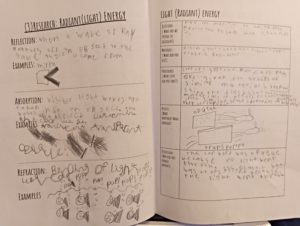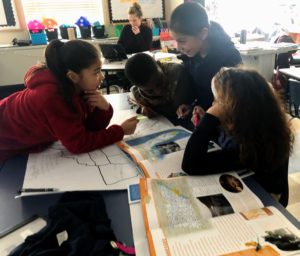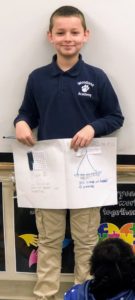Students will be respectful and active participants in their learning community.
This learning goal was chosen as one of the three overarching goals for one simple reason, if students do not feel safe and as though they belong in their classroom, they will not learn. At the very least they will not learn to their highest ability. In a classroom community which is full of students who are active participants and are respectful of one another, students will experience powerful and long lasting learning. Creating this type of learning community takes time, intentional planning, modeling, opportunities to practice and accountability. To see examples of how this learning community and collaboration network was created in Room 312 during the past year and the results of such an environment click here.
Students will think as readers, writers, mathematicians, scientists, and historians.

Students practiced doing research through multiple sources and completed a lab report while completing and experiment.
The second learning goal focuses on the students strictly academic learning and achievement. If students can feel confident enough to believe and take on identities such as reader, writer, mathematician, scientist, or historian then they can succeed in school and envision themselves in these types of careers in the future.
As was discussed in my teaching philosophy, I believe that there is no point in education and school if we are not opening doors for students and preparing them for future paths. Through this learning goal students were able to take on these identities, practice the activities completed in these professions, and begin to explore the the world and possibilities around them. To see examples of my students thriving and exploring as readers, writers, mathematicians, scientists, and historians, click here.
Students will grow from where they are, as students and people.
As previously discussed my role as a teacher is to take the student entering on day, wherever they may be at on that day and support, challenge, guide them through academic and personal development. This learning goal can of course be split up into two parts, the first part being the students academic growth, as you will see from the examples and evidence here, the students have made great strides over this year in every academic subject. The importance of this aspect of student growth and learning is straightforward, as it is what is tested and valued in all academic circles.
The piece that is missed in testing student learning and growth is the work students are doing to become people. By this I mean that students each year are developing emotional management/expression, they are developing character, and they are growing their personality. This is my favorite aspect of teaching! In practice this learning goal can often be the more emotional goal to work on and practice. It can involve frustration, tears, outbursts, squealing, awkwardness, and so many other emotions. Along with high emotion, usually accompanies great learning. As a teacher this growth often occurred in the hallway with a conversation either between a student and I or between multiple students with my job becoming mediator. This is when you get to students for who they are!


